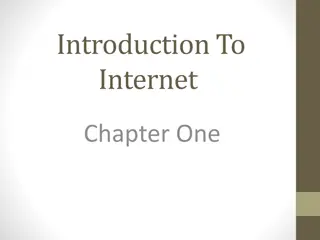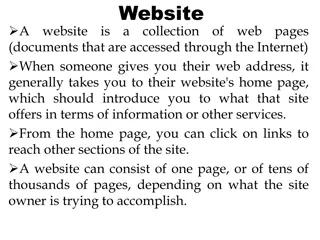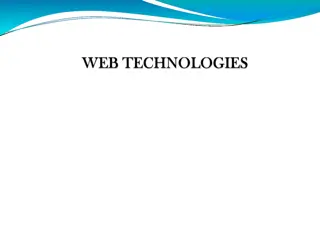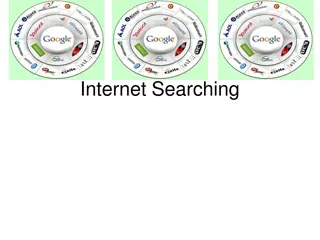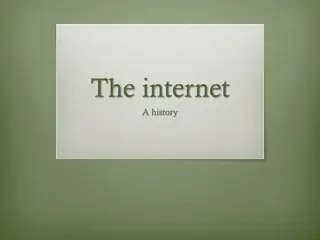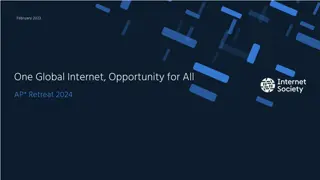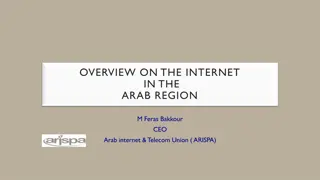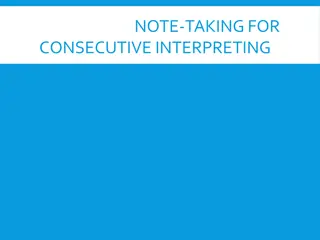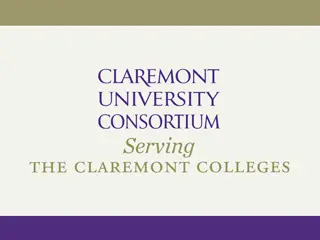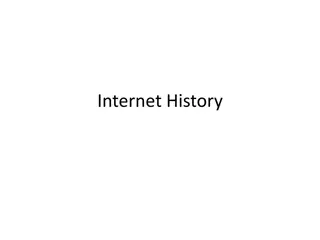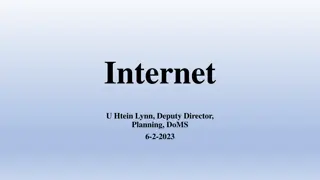
Evolution of Internet Technology and Infrastructure
Explore the history and development of the Internet, from the origins of ARPANet to the emergence of new technologies like packet switching, email, and the World Wide Web. Learn about client/server architecture, Internet addressing, and the significance of markup languages. Discover how the Internet has evolved into a global network connecting individuals and businesses worldwide.
Download Presentation

Please find below an Image/Link to download the presentation.
The content on the website is provided AS IS for your information and personal use only. It may not be sold, licensed, or shared on other websites without obtaining consent from the author. If you encounter any issues during the download, it is possible that the publisher has removed the file from their server.
You are allowed to download the files provided on this website for personal or commercial use, subject to the condition that they are used lawfully. All files are the property of their respective owners.
The content on the website is provided AS IS for your information and personal use only. It may not be sold, licensed, or shared on other websites without obtaining consent from the author.
E N D
Presentation Transcript
COM 3105 E-COMMERCE APPLICATION DEVELOPMENT Hans Yip
Learning Objectives Chapter 2 -Technology Infrastructure: Internet and the World Wide Web About the origin, growth, and current structure of the Internet How packet-switched networks are combined to form the Internet How Internet, e-mail, and Web protocols work About Internet addressing and how Web domain names are constructed About the history and use of markup languages on the Web How HTML tags and links work About the cost and performance of Internet connections technologies About Internet2 and the Semantic Web
Introduction of Internet Network Architecture Client/Server architecture. A client is defined as a requester of services. A server is defined as the provider of services. PC + PC => LAN (Local Area Network) LAN + LAN => MAN (Metropolitan Area Network) MAN + MAN => WAN (Wide Area Network) WAN + WAN => Internet NOTE: Internet is the largest WAN in the world.
History of Internet On February 7, 1958, US Department of Defense established the Advanced Research Projects Agency (ARPA), later renamed the Defense Advanced Research Projects Agency (DARPA). Two main goals for this networking project are: 1. Allowed scientists at different physical locations to share information and work together on military and scientific projects. 2. Could function even if part of the network were disabled or destroyed by a disaster such as a nuclear attack. By December 1969,the agency created a decentralized computer network known as ARPAnet. This network linked four computers located at the UCLA, Standard Research Institute, the UC Santa Barbara, and the University of Utah Each of these computers served as a host on the network. A host, more commonly known today as a server, is any computer that provides services and connections to other computers on a network.
ARPANet University of Utah Stanford Research Institute University of California Santa Barbara University of California Los Angeles
New Technologies from this Project Packet switching (from Circuit Switching) Email was implemented in 1972 Telnet Protocol for remote logon File Transfer Protocol (FTP) In 1989, Tim Berners-Lee and his colleagues at the European Particle Physics Laboratory CERN proposed the concept of linking documents with hypertext, and he created Hypertext Transfer Protocol (HTTP). (Creation of World Wide Web) In 1993, the introduction of Mosaic, the first graphical web browser (Netscape Navigator)
How does Internet Work? Internet uses a client/server networking principle When you enter the URL (http://www.mywebpage.com/myfile.html) of a web page into your browser and click GO The browser breaks the URL (Uniform Resource Locator) into three parts: The protocol ( http ) The server name ( www.mywebpage.com ) The file name ( myfile.html ) The browser makes a request to the Domain Name Server with the server name which translates the server name www.mywebpage.com into an IP address.
How does Internet Work? The browser then uses the IP address connecting to the server machine on port 80. Following the HTTP protocol, the browser creates a HTTP request with a GET request to the server, asking for the file myfile.html (cookies may be sent from browser to server with the HTTP request) The web server then sent a HTTP response with the HTML text for the web page to the browser (cookies may also be sent from server to browser in the header for the page) The browser reads and interprets the HTML tags and formats the page onto your screen.
HOW DOES INTERNET WORK?
HOW DOES INTERNET WORK?
HOW DOES INTERNET WORK?
Domain Name Map - click for larger image A MAP OF DOMAIN NAME OWNERSHIP AT STREET LEVEL FOR DOWNTOWN SAN FRANCISCO
ROUTER-BASED ARCHITECTURE OF THE INTERNET
The Browsers There are different web browsers in the market: Mozilla: Firefox for Windows & Linux Microsoft: Internet Explorer for Windows (Edge for Windows 10) Netscape for Windows Opera for mobile phones (Opera developed in Norway as a research project in 1994) Safari for Apple
The Web Server The Web Server is not only looking up a file (static web page). It can process information and generate a page based on the specifics of the query Dynamic web pages are generated by software such as CGI (Common Gate Interface) Common Web servers: Microsoft IIS (Internet Information Services) Apache
What is? Web Pages: contain HTML coding. Web Site: a collection of web pages. Web servers: Program that interpret HTTP requests and deliver the appropriate web page to your browser. Server-Side Programming: Programs that run on the server computer. Web Browsers: Program on the client computer that use to interpret and display web pages. Client-Side Programming: Programs that run on the client side. DNS (Domain Name Service): Convert Domain name into IP address. HTTP Requests: transmit from browser to server with method information (GET/POST) to request a web page. HTTP Responses: return from server to browser with status codes (200 ok, 204 no content, 401 not authorized, 403 forbidden, 404 not found, etc ) HTML Forms: web page contain fields where you can enter information. (<form></form>, <input />, <select></select>, <option></option>, etc ) GET and POST Requests: GET: encodes the message it sends into a query string, which is appended to the URL . POST: sends its message in the message body of the request. (data is encoded and sent via an HTTP request).
The Internet and World Wide Web Computer network is any technology allowing people to connect computers to each other internet (small i ) is a group of interconnected computer networks Internet (capital I ) connects networks all over the world The Internet is a global network of computers and mobile devices that allows individuals and businesses around the world to share information and other resources and conduct business transactions. host - is a computer or device directly connected to the Internet. Online - When a user connects to the Internet. A protocol is a standard or set of rules that computer network devices follow when transmitting and receiving data. Every computer and device connected to the Internet uses Transmission Control Protocol/ Internet Protocol (TCP/IP).
The Internet and World Wide Web IP Address (Internet Protocol Address): is a sequence of numbers that uniquely identifies the location of each computer or device connected to the Internet. Domain name: is a text-based name that corresponds to the IP address of a server that hosts a website. DNS server translates the domain name to its associated IP address. IPv4 -----------------> 74.125.224.72 IPv6 -----------------> 2001:4860:4860::8844 Domain name ----> google.com
COMMONLY USED DOMAIN NAMES
The Internet Blogs are locations that people can share ideas and information. Millions of people go online to share ideas and information by hosting and participating in blogs a process called blogging. Video sharing websites, sometimes called video blogging websites, such as YouTube and Vimeo, allow users to share and comment on personal and professional videos. Microblogging is sending brief text messages to subscribers, such as by using Twitter or other services to share status updates, links to articles, photos, and more.
Internet Activities Browsing and searching for information. Communicating with others through email, text or video chat, social networking, instant messaging, mailing lists, blogs and microblogs, and other media. Downloading and uploading files. Accessing remote computers or servers. Conducting business activities. Online shopping and bill payment.
Downloading and Uploading Files One of the most useful Internet activities is downloading files from a server or uploading files to a server. A server is a computer on a network used to store files. The Internet standard or protocol that you use to upload or download music, software, word processing, picture, and other files to a server is the File Transfer Protocol (FTP). Remote data access, storage, software access, and collaboration technologies are all aspects of cloud computing.
Remote Computing Technologies Virtual Private Network (VPN) - A VPN provides a secure, encrypted connection between a remote user and a local area network. Web conferencing or video calling allows remote employees to participate in meetings, training sessions, and more.
Conducting Business Activities Although people often use the terms e-business and e-commerce interchangeably. E-business refers to any use of the Internet to conduct a company s business. E-commerce refers to Internet use for the purpose of generating sales of goods or services, or creating and maintaining customer relations. E-commerce websites can be categorized by the participants involved in the transactions: Business-to-consumer (B2C) Business-to-business (B2B) Business-to-employee (B2E) Consumer-to-consumer (C2C)
Email and Other Communication Tools Online Communication Description Users must be online at the same time or not No Email Users send and receive text with or without attached files Two or more users take turns exchanging brief messages Users type text into a chat window; all users can see what other users type Many users play online games simultaneously, and can compete and interact with people all over the world Instant messaging (IM) and mobile instant messaging (MIM) Internet Relay Chat (IRC) or chatting Yes Yes Massive multiplayer online games (MMOGs) Yes
Email and Other Communication Tools Online Communication Description Must users be online at the same time or not No Newsgroups and mailing lists Users subscribe to a newsgroup discussion or mailing list on a certain topic and receive messages about that topic Users share web links to articles, videos, photographs, and webpages, and can use tags to organize their bookmarks Users share status updates, microblogs, photos and video, links, and personal commentary using a variety of online tools Social bookmarking No Social networking No
Other Internet Services Email (Electronic mail): is the transmission of messages and files via a computer network. An email client is any program used to create, send, and receive email messages. To use some email clients, you download and install the program or app on your computer or mobile device and instruct it to manage your incoming email from a server or a web-based email service. When you install an email client, you must set it up to sync and download email from your email address.
Email Email messages travel over the Internet using the same packet-switching technology and TCP/IP suite that govern all communications over the Internet. An email client might use the following protocols to interact with mail servers when sending and receiving messages: SMTP (Simple Mail Transfer Protocol) for sending email. POP (Post Office Protocol) for receiving email. IMAP (Internet Message Access Protocol) for receiving email. HTTP (Hypertext Transfer Protocol) for web-based email.
Email Client and Server NOTE: SMTP server listens on port 25, POP3 listens on port 110 and IMAP listens on port 143
Other Internet Services VoIP, short for Voice over IP (Internet Protocol): enables users to speak to other users via their Internet connection. (Skype)
World Wide Web The World Wide Web, commonly called the web, is a subset of the Internet. The web includes a vast collection of documents called webpages, which can include text, pictures, sound, animation, or video. A website is a collection of related webpages. A markup language is a coding system that uses tags to provide instructions about the appearance, structure, and formatting of a document. Webpages use markup languages to define the layout and/or content of the pages. Web designers use Hypertext Markup Language (HTML) codes to define the layout and structure of a webpage. The HTML markup language uses predefined codes called HTML tags to define the format and organization of webpage elements.
World Wide Web Cascading style sheets (CSS) are documents that specify design aspects of a webpage, such as fonts and colors. You can create a webpage using a simple text editor program, such as Notepad, or using WYSIWYG (What You See Is What You Get) web authoring software, such as Adobe Dreamweaver or an online content management system, such as WordPress. To share a webpage or website with others, you must upload, or publish, it to a web server so that other users may access it. A web server is a computer that stores webpages. You can access and view webpages using a software program called a web browser, or browser. Popular browsers for laptops and PCs include Google ChromeTM, Mozilla Firefox, Microsoft Internet Explorer (Edge for Windows 10), and Apple Safari.
World Wide Web Webpages connect to other webpages using hyperlinks. A hyperlink, or link, is text or a picture on a webpage that you tap or click to view a different location on the same webpage, another webpage at the same website, a webpage at a different website, or to an email address, or PDF document. Exploring the web by moving from one webpage to another is sometimes called browsing or surfing the web. A search tool is a web-based resource that helps you find specific information on the web. One type of search tool is a search engine, such as Google or Bing, which you can use to search for webpages that contain specific keywords or phrases.
History of Internet On February 7, 1958, Department of Defense (DoD) created the Advanced Research Project Agency (ARPA). Phone systems work by using a technology known as circuit switching. Circuit switching allows a caller to dial a number to establish and maintain a private circuit across the wires. In 1961, Leonard Kleinrock, a scholar at the University of California, Los Angeles (UCLA), wrote his doctoral dissertation and outlined the idea of data networking and packet switching. Packet switching involves separating data from a sending computer or device into small units known as packets, sending each packet independently over cables, and then reassembling the packets on the receiving computer or device. NOTE: Each packet even can follow different routes to its destination.
History of Internet In 1966, ARPA funded a new network of computers, called ARPANET. The computer at UCLA is the first computer on ARPANET. The computer at the Stanford Research Institute (SRI) is the second on ARPANET. By December 1969, the University of California Santa Barbara and the University of Utah joined the ARPANET network, making these four university connections the foundation of the global network known today as the Internet. In 1972, Robert Kahn and Vinton Cerf developed two new protocols for ARPANET, TCP and IP.
THE ARPA NETWORK
History of Internet Transmission Control Protocol (TCP) provided flow control over the network and error checking for lost packets. Internet Protocol (IP) addressed and sent the packets. NOTE: In 1983, DARPA (Defense Advanced Research Projects Agency) mandated the use of this suite of communications protocols, referred to as TCP/IP. Since then, every computer and device connected to the Internet has used TCP/IP to communicate. Late in 1971, Ray Tomlinson, a scientist at Bolt Beranek and Newman (BBN), developed the first email program that could send and receive messages to and from remote computers. 1975 brought the first mailing list, titled SF-Lovers, for science fiction fans among the ARPA community. A mailing list allows participants to send a single message to the list, which then automatically routes the message to every other participant.
History of Internet In 1985, the National Science Foundation (NSF) established a new network called NSFNet. backbone is the main long-distance lines and the hardware that connect computers to the Internet. By 1990, the success of the NSFNet led to the shutdown of ARPANET. NSFNet became the main network linking universities and research facilities. The military portion of ARPANET became a separate network called MILNET, which is now known as NIPRNET (Nonsecure Internet Protocol Router Network). In the mid-1990s it became common to use English-language names to identify computer hosts, rather than the long series of numbers originally used. In 1995, the NSF moved the connections from the original NSFNet backbone to a commercial Internet backbone supported by commercial network providers.
History of World Wide Web In the early 1990s, Tim Berners-Lee, who was working at CERN in Switzerland, envisioned the use of hyperlinks to make connections between related ideas in separate documents. Hypertext, which is a system of hyperlinks that allows users to tap or click on a word to jump to another location. With the help of his CERN colleague Robert Cailliau, Berners-Lee created three technologies: created HTML, used to create documents that can include text, graphics, and links. created a special software program to read and display HTML documents, the first browser known as WorldWideWeb (spelled with no spaces). created Hypertext Transfer Protocol (HTTP),a protocol that defines how HTML documents transmit to a browser.
History of World Wide Web Marc Andreessen and Eric Bina, two University of Illinois graduate students employed at the university s National Center for Supercomputing Applications (NCSA), created the Mosaic browser in March 1993. The next year, Andreessen and Jim Clark founded a new company, Netscape Communications. During the summer of 1994, the company created the first commercial browser, called Netscape Navigator.
Connecting to the Internet A local area network (LAN) connects computers using cables or wireless capabilities within a building or campus so users can share data and resources. An Internet service provider (ISP) is a business that has a permanent Internet connection and provides temporary Internet connections to individuals and companies. A mobile service provider, sometimes called a wireless data provider, offers wireless Internet access to computers and mobile devices that have wireless capabilities. ISPs are classified either as regional or national: A regional ISP provides Internet access for customers (individuals or businesses) in a specific geographic area. A national ISP provides Internet access in most major cities and towns nationwide. National ISPs may offer more services and generally have larger technical support staffs than regional ISPs.
Connecting to the Internet The speed of an Internet connection depends on bandwidth, which is the capacity of the communications channel. The speed at which data travels from one device to another is the transfer rate. Transfer rates measure the number of bits the line can transmit in one second (expressed as bits per second, or Bps). Transfer rates range from thousands of bits per second (kilobits per second or KBps) to millions of bits per second (megabits per second or MBps), and even billions of bits per second (gigabits per second, or GBps).
Connection Methods (Wired) CABLE: Cable television (CATV) lines enable home or business users to connect to the Internet over the same coaxial cable that delivers television transmissions. Cable Internet connections require a coaxial cable, a line splitter that divides the television signals from the data signals, a cable modem, and a network expansion card inside the computer. A cable modem is a particular type of modem used for high- speed cable connections.
Connection Methods (Wired) DIGITAL DEDICATED LINES: Unlike a dial-up line in which the connection is reestablished each time it is used, a dedicated line is a constant connection between two communications devices that uses the local phone network. Three popular types of digital dedicated lines are: Integrated Services Digital Network (ISDN) lines digital subscriber lines (DSL) T -carrier lines
Connection Methods (Wired) Integrated Services Digital Network (ISDN) is a set of standards for digital transmission of data over standard copper phone lines. With ISDN, the same phone line that could carry only one computer signal now can carry three or more signals at once, through the same line, using a technique called multiplexing. Multiplexing allows for more data to transmit at the same time over the same line.
Connection Methods (Wired) Digital subscriber line (DSL) is another digital line alternative for the small business or home user. A DSL transmits at fast speeds on existing standard copper phone wiring. Some of the DSL installations can provide a dial tone, so you can use the line for both voice and data. An asymmetrical digital subscriber line (ADSL) is a type of DSL that supports faster transmissions when receiving data than when sending data. ADSL is ideal for Internet access because users generally download more data from the Internet than they upload.


